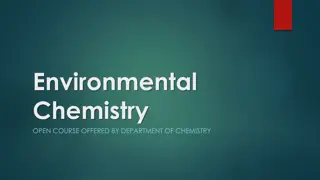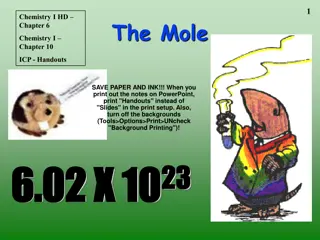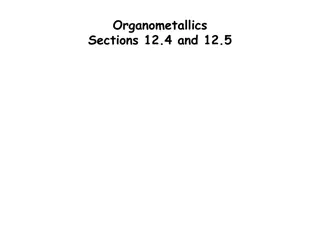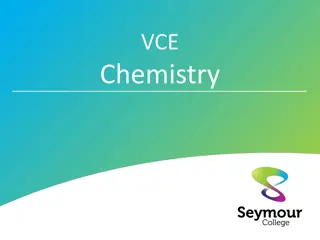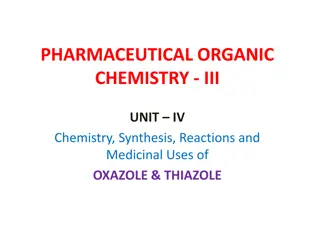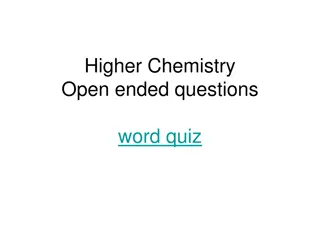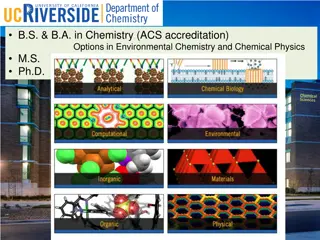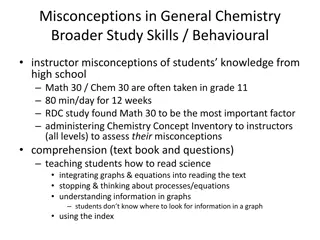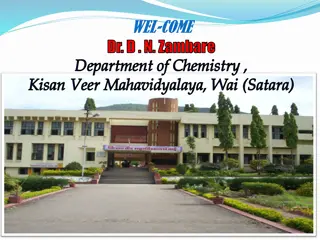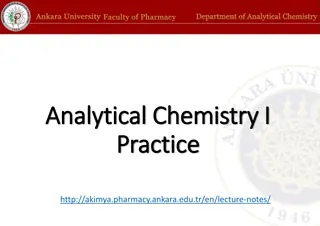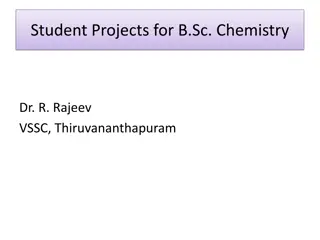Exploring Supramolecular Chemistry: Insights and Applications
Supramolecular chemistry delves into the chemistry of molecular assemblies, intermolecular bonds, and non-covalent interactions, leading to the formation of supra-molecules through aggregation of molecular subunits. Concepts like molecular recognition, self-organization, and host-guest chemistry play pivotal roles in this field. The stability of supra-molecular complexes relies on principles of pre-organization and structural recognition. Classification includes cavitands and clathrands based on topological relationships, and podands based on structural features, showcasing the diverse realms of supramolecular chemistry.
- Supramolecular Chemistry
- Molecular Assemblies
- Non-covalent Interactions
- Host-Guest Chemistry
- Molecular Recognition
Download Presentation

Please find below an Image/Link to download the presentation.
The content on the website is provided AS IS for your information and personal use only. It may not be sold, licensed, or shared on other websites without obtaining consent from the author. Download presentation by click this link. If you encounter any issues during the download, it is possible that the publisher has removed the file from their server.
E N D
Presentation Transcript
SUPRAMOLECULAR CHEMISTRY ---an insight DR. SHYAMA NAIR ASSO. PROFESSOR DEPARTMENT OF CHEMISTRY NSS COLLEGE PANDALAM
SUPRAMOLECULAR CHEMISTRY Chemistry of molecular assemblies & of intermolecular bonds Chemistry beyond the molecule & as the chemistry of non- covalent bond Intermolecular interaction interactions, etc It shows selectivity or other functionality Supra molecules are formed by aggregation of molecules, called molecular subunits Molecular chemistry covalent bonding Supra molecular chemistry molecular interactions Host Guest chemistry. by H bonding, pi-pi
The roots of supra molecular chemistry has reached from three concepts Fixations : Concept of receptors. Recognition : principle of selective binding Co-ordination : interaction and affinity between the partners Molecular Recognition, Self Organizations and Self Assembly are the central concepts in supra molecular chemistry.
The stability of supra molecular complex depends on two principle; Principle of pre-organization Principle of complimentary or structural recognition
HOST-GUEST CHEMISTRY Host component is an organic molecule or ion whose binding sites converge in the complex Guest component is any molecule or ion whose binding site diverge in the complex The host molecule selectively binds the guest molecule to form a stable host-guest complex, through weak non covalent interactions
CLASSIFICATION OF SUPRA MOLECULAR HOST & GUEST COMPOUNDS According to the relative topological relationship between host and guest; a) Cavitands : Host with intermolecular cavities. The host, guest aggregrate is called cavitate. eg : cyclodextrins,calixarenes . b) Clathrands : Host with extramolecular cavities. The Host guest aggregrate is called clathrate. eg : Zeolites MOF cyclodextrins Zeolites
Based on structural features; a) Podands : Linear or branching chain with guest binding functional group. High degree of flexibility to conformational change on binding b) Cyclic host: Nine or more atoms in ring which contain no. of binding sites in a closed ring arrangement. They require less conformational change upon binding
MOLECULAR RECOGNITION Component of supra molecule have been named receptor and substratre Receptor (Host) selectively binds substrate (Guest) and form a stable complex It is mainly through weak forces According to Lehn, a supra molecular complex is characterized by the energy and the information involved in its binding by the selection of substrates by a given receptor molecule and sometimes by a specific function.
FORCES INVOLVED IN MOLECULAR RECOGNITION
ION-ION INTERACTION Comparable strength to that of covalent bonding Bond energy is 100 to350 KJ/mol It is non- directional in nature
ION-DIPOLE INTERACTION THE INTERACTION OF ION WITH POLAR MOLECULE BOND ENERGY IS 50 TO 200 KJ/mol Usually occur in solid and solutions
DIPOLE-DIPOLE INTERACTION Dipole of one molecule interact with dipole of other molecule Bond energy is 5-50 KJ/mol The strength of dipole-dipole interaction depends on the size of both dipoles
HYDROGEN BONDING Weakest bond between H atom & other electronegative atom (same or different) Presence of H bond increase m.p. & b.p. H bond increase solubility of a substance H- bonding are represented as D-H-A (D=donor, A=acceptor) Bond energy is 4-60 KJ/mol
van der waals interactions Weak electrostatic interactions Polarization of an electron cloud by positive charge of adjacent nucleus The bond energy is 0.4-4 KJ/mol They are non-directional and hence possess only limited scope in the design of specific hosts for selective binding of particular guests. Two types of VAN DER WAALS INTERACTIONS : a) London force (dispersion force) b) Exchange-repulsion force
HYDROPHOBIC INTERACTIONS It arises from the exclusion of non polar groups or molecule from aq. Solution The energy is less than 40 KJ/mol The hydrophobic interactions are important in biological system Hydrophobic effects can be divided into two energetic components a) Enthalpic hydrophobic effects b) Entropic hydrophobic effects
MOLECULAR RECOGNITION IN ENZYME CATALYSIS





